Top 10 Most Expensive Champagne Bottles
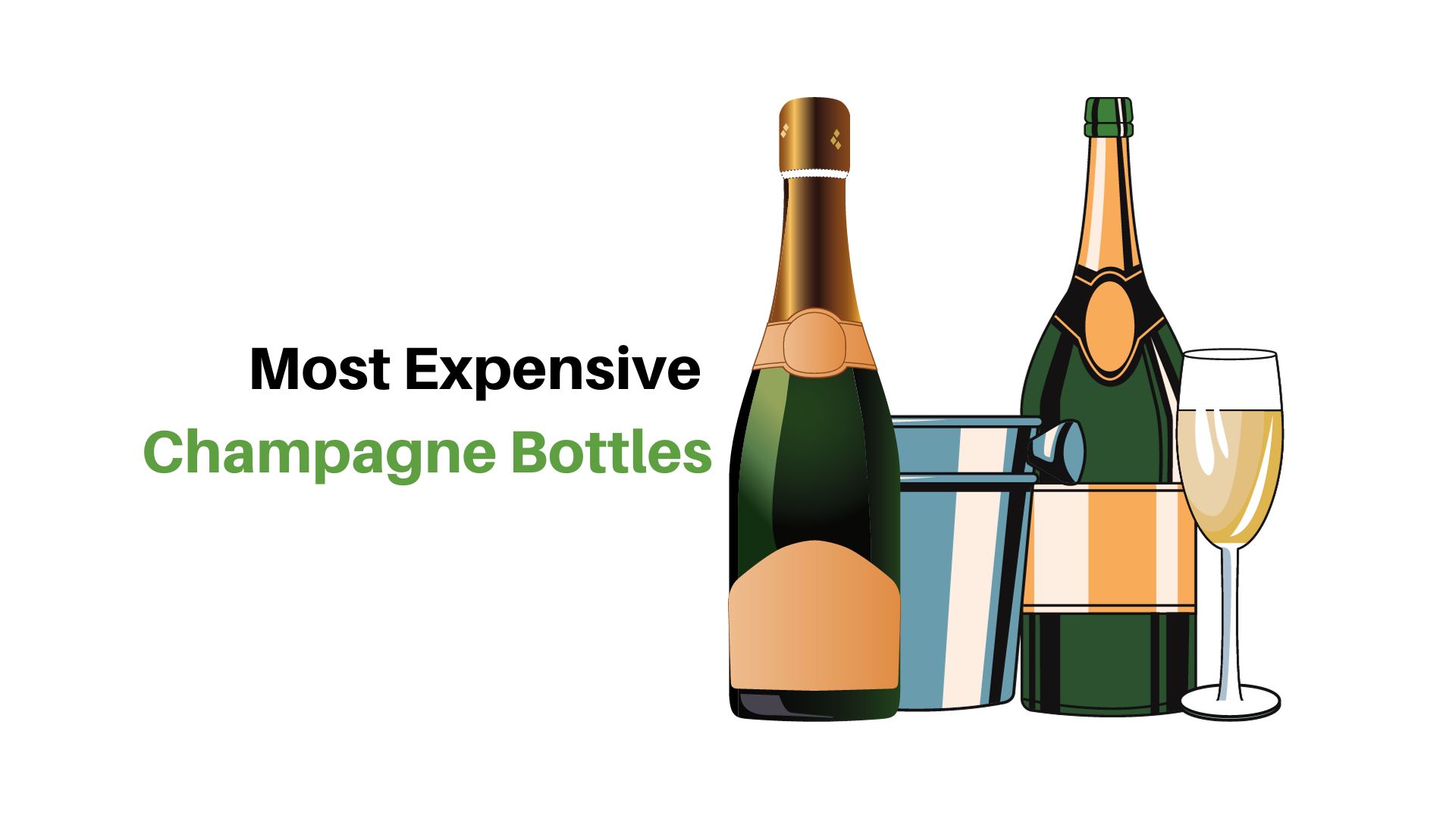
Page Contents
Introduction
Most Expensive Champagne Bottles – Champagne is a celebratory drink for many occasions and hails from France. It is crafted from various types of grapes while giving it a crisp and acidic flavour along with some sweet drops for the taste. There are various types of Champagne discussed in the Top 10 Most Expensive Champagne Bottles. Champagne can be paired with a variety of foods, that includes meals or dinners. Champagne is associated with luxury, rich history, mouth-lingering taste, and toast for joyous occasions. Moderate drinking should provide no harm to health but rather provide many health benefits.
What is Champagne?
Champagne is a sparkling wine produced in the Champagne region of France. It is known for its elegance, effervescence, and association with celebrations and luxury. The name “Champagne” is legally protected and can only be used to label sparkling wines that come from this specific region and adhere to specific production methods.
Champagne is made primarily from three grape varieties: Chardonnay, Pinot Noir, and Pinot Meunier. The region's unique climate, with its cool temperatures and chalky soils, contributes to the grapes' distinctive characteristics. The grapes are harvested, and the juice is fermented in a process that involves two fermentation stages.
The first fermentation produces a base wine, which is then bottled along with a mixture of yeast and sugar called the “liqueur de tirage.” This triggers the second fermentation within the bottle, during which carbon dioxide is trapped, creating characteristic bubbles. The wine is aged on its lees (the spent yeast cells) for a minimum of 15 months, although some Champagne houses age their wines for much longer periods.
After ageing, the process of riddling takes place, where the bottles are gradually rotated and tilted until the lees settle in the neck of the bottle. The neck of the bottle is then frozen, and the frozen plug of the lens is removed in a process called disgorgement. The bottle is topped up with a mixture called the “liqueur d'expédition,” which determines the wine's sweetness level, ranging from very dry (Brut Nature or Extra Brut) to sweet (Demi-Sec).
Champagne is known for its complex flavours and aromas, which can include notes of citrus, apple, pear, brioche, toast, and floral elements. It is typically served chilled in tall, slender flutes to showcase its bubbles and maintain its temperature. Champagne is enjoyed on its own as an aperitif or paired with a variety of foods, including seafood, poultry, cheeses, and desserts.
It's worth noting that while Champagne specifically refers to sparkling wine produced in the Champagne region, similar sparkling wines made using the traditional method in other parts of the world are often referred to as “sparkling wine” rather than Champagne, to respect the regional designation.
Types of Champagne
The few primary and traditional types of Champagne are:
- Pinot Noir: It is a sparkling wine made from a variety of grapes. It is famous for its fruit flavours and aromas.
- Chardonnay: This is made from white grapes and is mild in flavour. While drinking you can feel the crispiness and acidic taste.
- Pinot Meunier: This Champagne is made from black grapes, and is famous for its blend of fruitful taste and richness.
- Brut Nature: One of the driest Champagne and includes no sugar.
- Extra brut: More drier than Brut, but has a small amount of sugar.
- Brut: commonly consumed Champagne with low added sugar and dry in taste.
- Extra dry: Sweeter than Brut and comparatively sweeter.
- Dry: It is moderately dry.
- Demi-sec: The feeling of sweetener, can be enjoyed with dessert wine.
- Doux: Most sweetest Champagne of all and includes a high level of sugar.
Food Pairings
- Brut Nature: A great choice for pairing with cured meats, sushi, potato chips, and briny oysters.
- Extra Brut: A great choice for pairing with grilled fish, light salads, other seafood dishes, shrimp cocktail and goat cheese.
- Brut: A great choice for pairing with roasted chicken, creamy cheeses, fried appetisers, and mushroom dishes.
- Extra Dry: A great choice for pairing with cheeses, foie gras, mildly spiced dishes, Indian or Thai cuisine, and buttery pastries.
- Dry: A great choice for pairing with Gouda, lobster bisque, creamy pasta dishes, and roasted pork
- Semi-Sec: chocolate truffles, almond-inclusive pastries, fruit tarts, and creamy desserts.
- Doux: Blue Cheeses, Crème brûlée, and fruit inclusive desserts.
Benefits of Champagne
Benefits are related to low or moderate levels of drinking.
- Champagne is good for the skin, it has antibacterial properties.
- Helps to increase antioxidants in the body and prevent cholesterol
- Maintains blood pressure.
- Provide natural antioxidants to the body and can prevent diseases such as Parkinson's and Alzheimer's.
- It is low in calories.
General Champagne Statistics
- As of 2022, around 326 million Champagne bottles were shipped crossing the highest number of bottles in the last 15 years.
- The following percentage of consumers with Champagne preferences are Chardonnay (31%), Meunier (31%) and Pinot Noir (38%).
- The top external markets for Champagne in 2022 as exports are the United States of America (34.1 million bottles), the United Kingdom (29.9 million bottles), Japan (13.8 million bottles), Germany (11.1 million bottles), Belgium (10.3million bottles), Australia (9.9 million bottles), Italy (9.2 million bottles), Switzerland (6.1 million bottles), Spain (4.4 million bottles) and the Netherlands (3.9 million bottles).
- 34% of revenue comes alone from France out of which 59% belong to Champagne House and 41% comes from Champagne Cooperatives and Growers.
- As of 2022, the United States of America generated € 793.5 million in value for Champagne bottles.
Top 10 Most Expensive Champagne Bottles In The World
- Taste of Diamonds (2013) – (Worth USD 2.07 million)
- Champagne Avenue Foch (2017) – (Worth USD 2.5 million
- Armand de Brignac Rose 30-Litre Midas (2013) – (Worth USD 275,000)
- Heidsieck (1907) – (Worth USD 275,000)
- NV Armand de brignac Brut Gold Midas – (Worth USD 51,600)
- Perrier- Jouët (1874) – (Worth USD 50,735)
- Dom Perignon Rose Gold Methuselah (1996)- (Worth USD 49,000)
- Juglar Cuvee (1820) – (Worth USD 43,500)
- Veuve Clicquot (1841) – (Worth USD 34,000)
- Louis Roeder, Cristal Brut 1990 Millennium Cuvee Methuselah – (Worth USD 18,800)
You May Also Like To Read:
- Drinking At Work Statistics
- Alcoholism Statistics
- Most Expensive Alcoholic Drinks
- Most Expensive Tequilas
#1. Taste of Diamonds (2013) – (Worth USD 2.07 million)
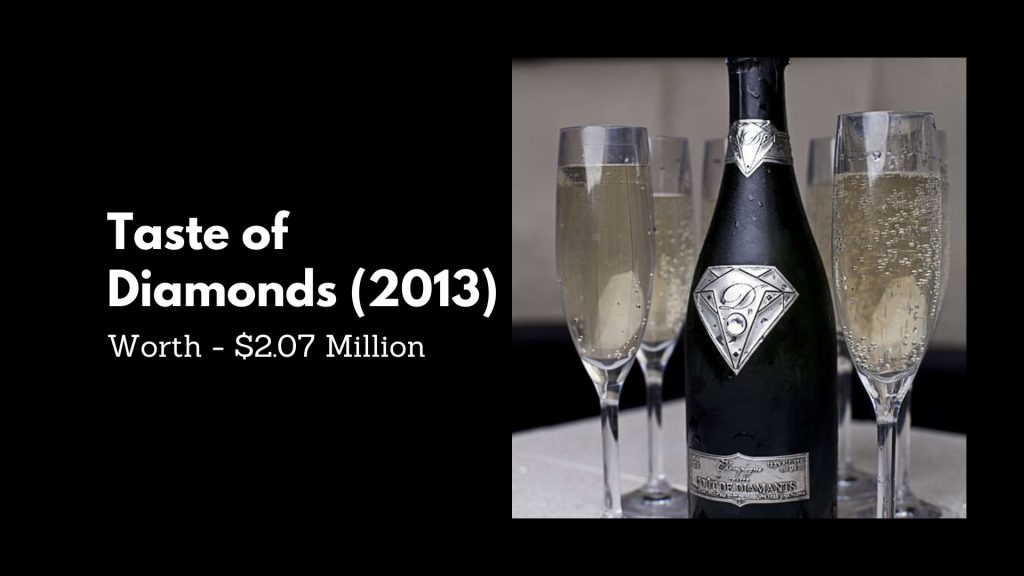 (Source: trendhunter.com)
(Source: trendhunter.com)
The top-ranked in the list of Top 10 Most Expensive Champagne Bottles is Taste of Diamonds (2013), and even today it has secured its rank. The bottles are a blend of Pinot Meunier, Grand Cru Chardonnay and Pinot Noir. It creates a creamy texture and is extremely refreshing. It has also won the “Best Taste” Award in 2012 as stated by Champagne Business News. This bottle is sold at $2.07 million.
#2. Champagne Avenue Foch (2017) – (Worth USD 2.5 million
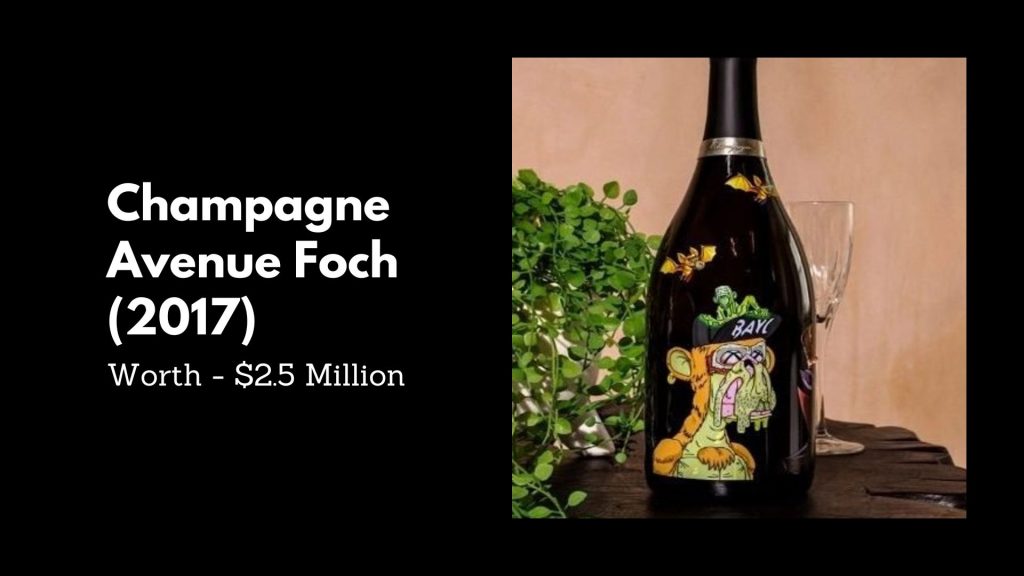 (Source: larazon.es)
(Source: larazon.es)
The second most expensive in the list of Top 10 Most Expensive Champagne Bottles are Champagne Avenue Foch (2017). To be frank, it cost $2.5 million because it has NFT of the bored Mutant Ape on the bottle.
#3. Armand de Brignac Rose 30-Litre Midas (2013) – (Worth USD 275,000)
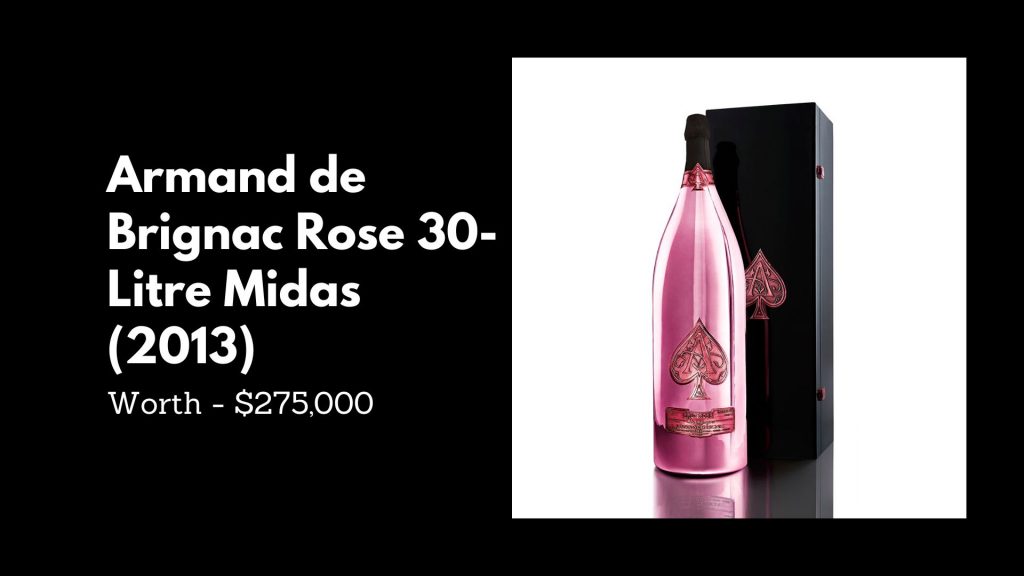 (Source: champagneking.co.uk)
(Source: champagneking.co.uk)
This gigantic bottle of 4 feet and more than 40 pounds can help a party flooded with thousands of people. The uniqueness of this bottle has helped its prices soar high and sell at $275,000.
#4. Heidsieck (1907) – (Worth USD 275,000)
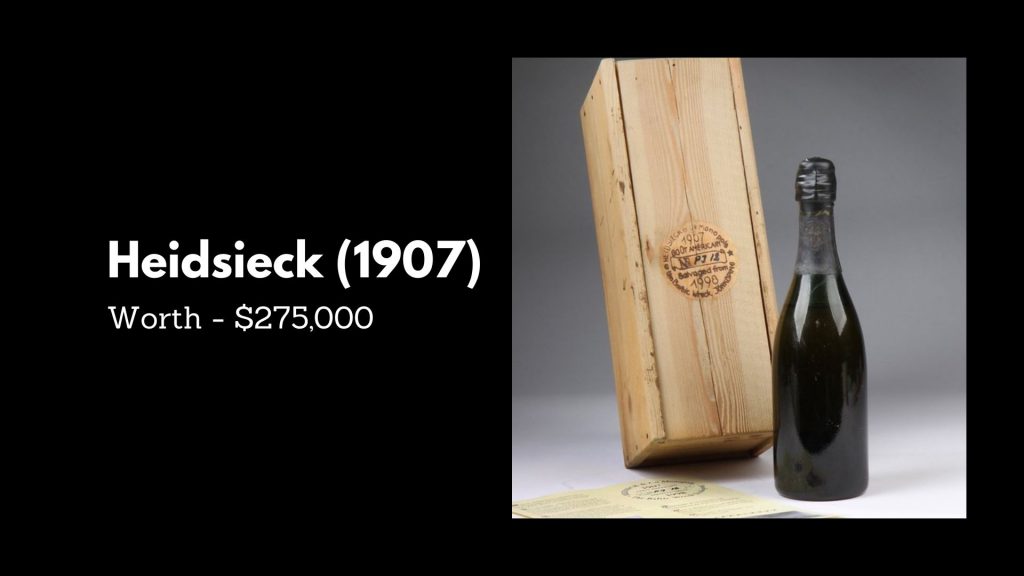 (Source: catawiki.com)
(Source: catawiki.com)
Another bottle found in the Baltic Sea sank in 1916 while going to Romanovs along with a Champagne Cargoship. In the late 90s, some divers found the bottle at the seabed which was sold at a whooping price of $275,000
#5. NV Armand de brignac Brut Gold Midas – (Worth USD 51,600)
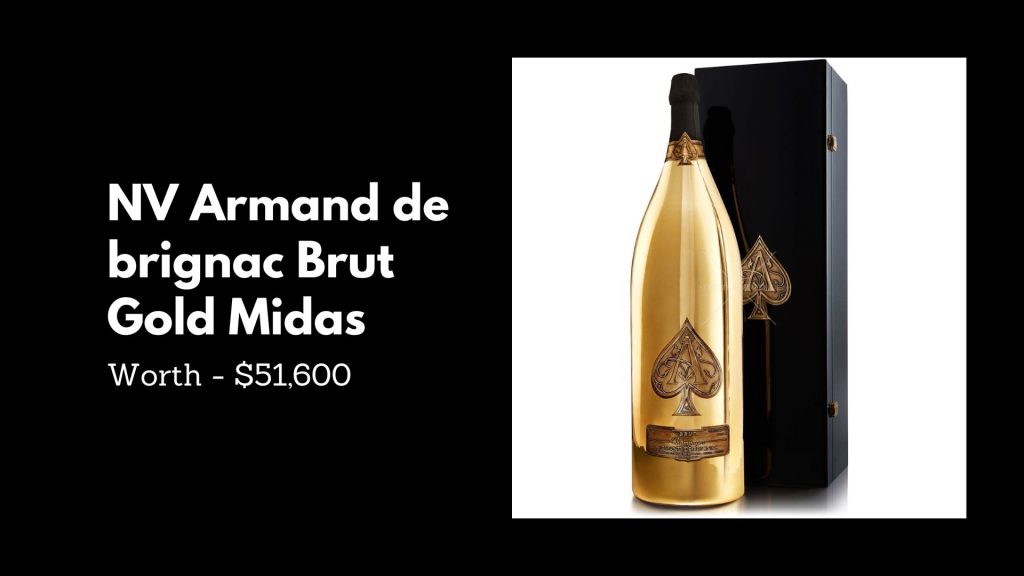 (Source: urban-drinks.de)
(Source: urban-drinks.de)
The owners of this Champagne are Jay- Z and Cattier family with production rights. This includes a luxurious effect and you can show it off. It sells for around $51,600.
#6. Perrier- Jouët (1874) – (Worth USD 50,735)
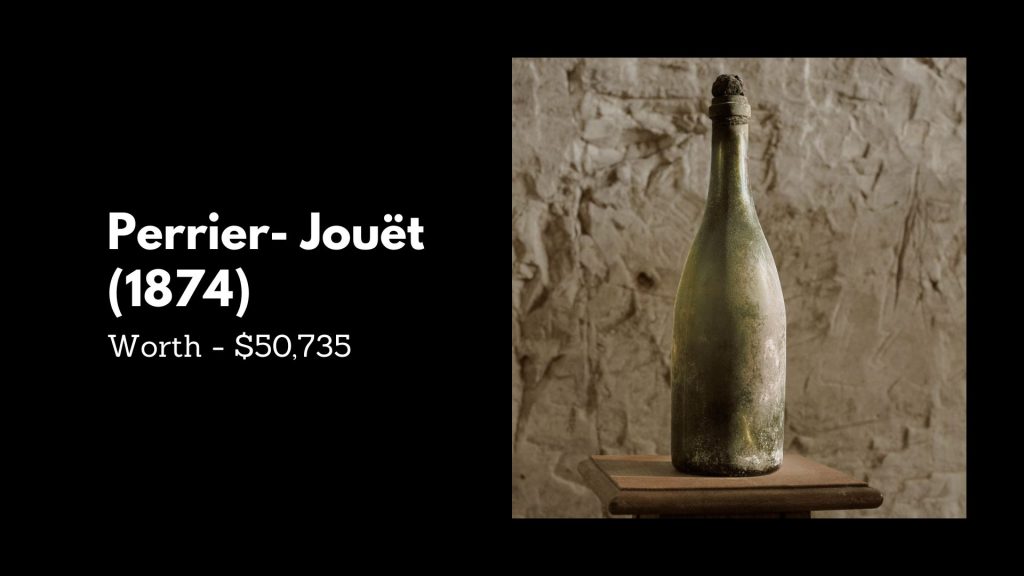 (Source: terredevins.com)
(Source: terredevins.com)
This Champagne was made by Charles Perries including Chardonnay. This bottle of champagne is extremely old and broke the auction records in 1888 being sold at $50,735.
#7. Dom Perignon Rose Gold Methuselah (1996)- (Worth USD 49,000)
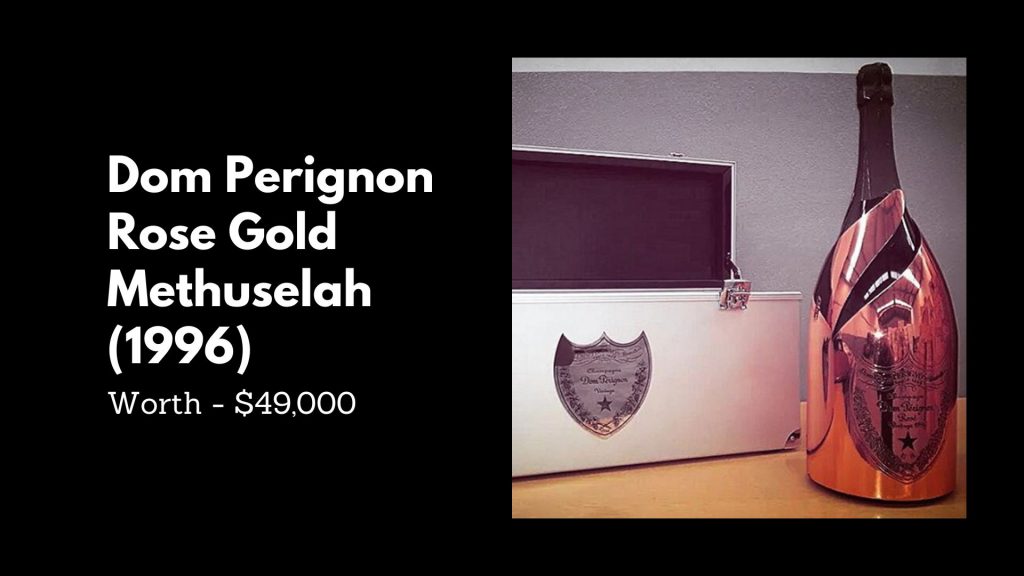 (Source: financesonline.com)
(Source: financesonline.com)
With the limited editions of gold-plated bubbly Champagne, only 35 bottles were sold. Dom Perignon Rose Gold Methuselah (1996) has a smoky flavour and is strong as well. Therefore it cost $49,000.
#8. Juglar Cuvee (1820) – (Worth USD 43,500)
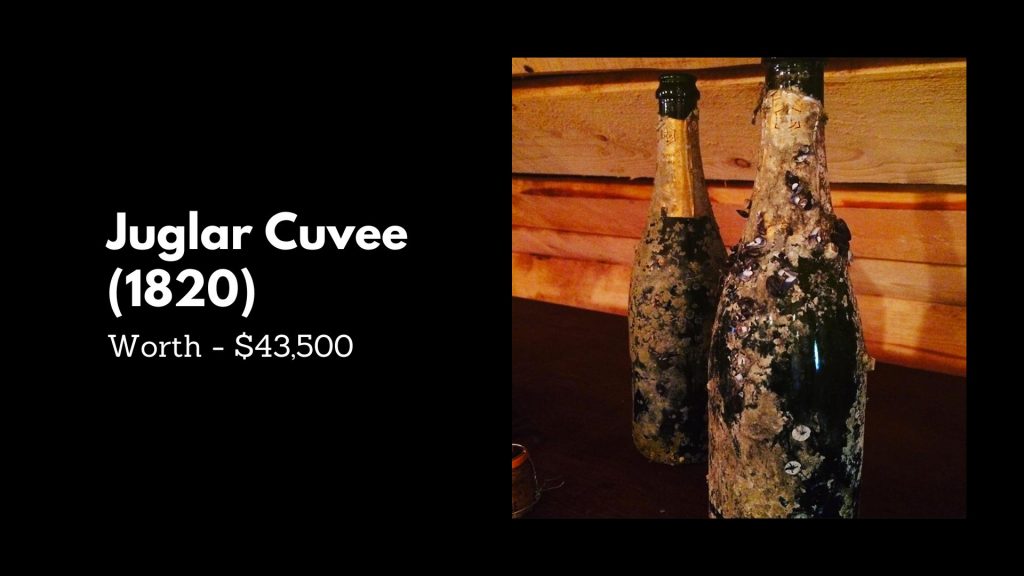 (Source: financesonline.com)
(Source: financesonline.com)
These bottles of Champagne were seen floating on sea after a shipwreck. It was said that this belonged to the 1840s era. It was then purchased at $43,500.
#9. Veuve Clicquot (1841) – (Worth USD 34,000)

These bottles of Champagne were found under a wrecked ship in the Baltic Ship. It was brought to the surface in 2010. During the auction, it crossed the numbers and was sold at $34,000.
#10. Louis Roeder, Cristal Brut 1990 Millennium Cuvee Methuselah – (Worth USD 18,800)
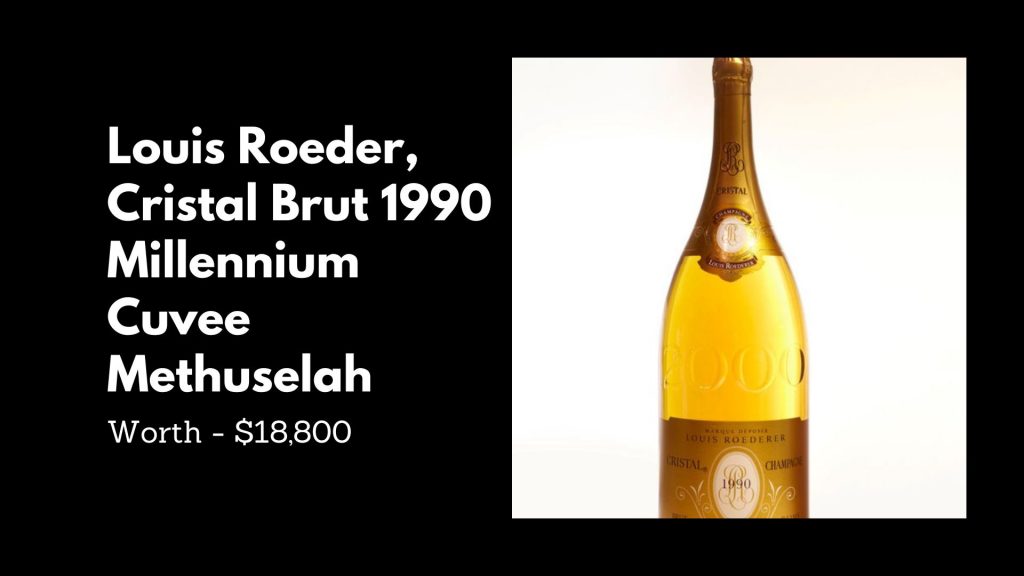 (Source: auction.catawiki.com)
(Source: auction.catawiki.com)
This Champagne is the rarest Champagne in the world. In one case six litres or 8 normal bottles are delivered. Louis Roeder, Cristal Brut 1990 Millennium Cuvee Methuselah is called rare because only 2,000 bottles were produced making it cost $18,000.
Tips to Store Champagne Bottles
- Temperature: Champagne should be stored in a cool and consistent environment. The ideal temperature range is between 45°F (7°C) and 55°F (13°C). Avoid storing Champagne in places that experience extreme temperature fluctuations, such as near a heating vent or in direct sunlight.
- Avoid light exposure: Champagne is sensitive to light, which can degrade its flavour and cause premature ageing. Store Champagne bottles in a dark place or cover them with a cloth or a wine bag to protect them from light.
- Horizontal position: Store Champagne bottles horizontally, lying on their side. This position keeps the cork moist, preventing it from drying out and potentially allowing air to enter the bottle. An air-dried cork can lead to oxidation and spoilage of the wine.
- Humidity: Champagne prefers a moderately high level of humidity, ideally around 70%. Higher humidity helps keep the cork moist and prevents it from shrinking. This prevents air from seeping into the bottle and ensures the Champagne remains fresh.
- Avoid vibrations: Champagne is also sensitive to vibrations, which can disturb the sediment in the bottle and affect the ageing process. Choose a stable location with minimal vibration to store your Champagne bottles.
- Avoid strong odours: Champagne can easily absorb odours from its surroundings, potentially affecting its flavour. Keep Champagne away from strong-smelling substances like cleaning chemicals or spices.
- Store away from food: While Champagne is often stored in the refrigerator before serving, it's best to keep it away from other food items. Strong food odours can permeate the Champagne's cork and taint its flavour.
- Ageing potential: Non-vintage Champagne is generally intended to be consumed within a few years of purchase. However, vintage Champagnes can develop more complex flavours with age. If you have a vintage Champagne with ageing potential, consider a wine cellar or a temperature-controlled wine storage unit to allow it to mature gracefully.
Conclusion
In conclusion in the Top 10 Most Expensive Champagne Bottles, let's make a toast to these expensive bottles. Originating from France it has spread its demand all over the world and is currently demanded by millions of people on various celebratory occasions. While beer has more calories, and takes many bottles for effect, Champagne has immediate and strong as well as long-lasting effects on the body. With these expensive bottles, each of them has its own history and therefore is charged in thousands and millions.
FAQ.
Champagne is a variant of sparkling wine and originates from the France region. It is produced using grapes and fermented in the bottle giving it a bubble effect.
Storing the Champagne in the refrigerator is good for a short time only. If you want to store it for a longer period of time you can refer to the mentioned guidelines about humidity, temperature and light conditions.
Once opened, it can last for at least 1 to 3 days unless and until it is perfectly sealed and refrigerated.
Champagne can be purchased from Wine stores, Duty-free stores, Supermarkets, Grocery stores, Liquor stores and online stores of official websites.

Aditi is an Industry Analyst at Enterprise Apps Today and specializes in statistical analysis, survey research and content writing services. She currently writes articles related to the "most expensive" category.